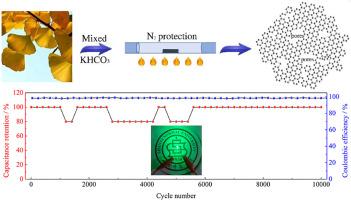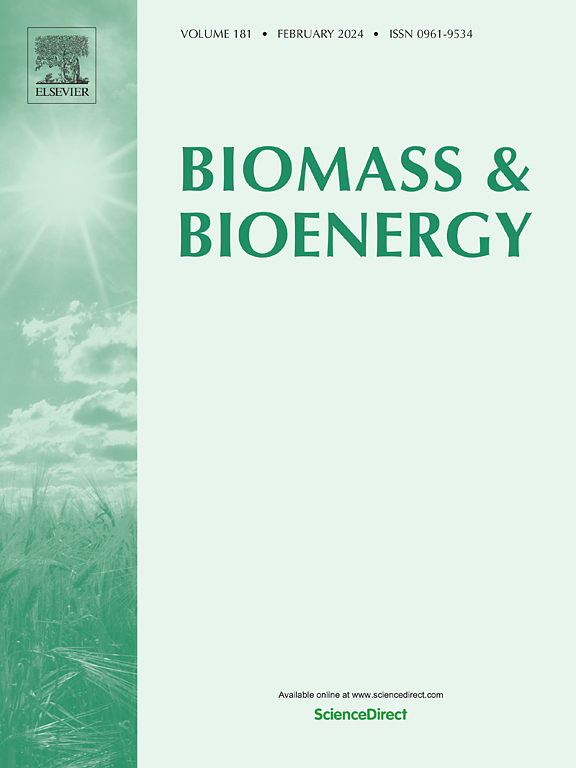Porous and high specific surface area carbon material derived from ginkgo leaves for high-performance symmetric supercapacitors
IF 5.8
2区 生物学
Q1 AGRICULTURAL ENGINEERING
引用次数: 0
Abstract
Carbon materials have the advantages of large surface area, high conductivity and stable chemical properties, and are widely used in the field of electrochemical energy storage. However, carbon materials currently have some problems such as high cost, complicated process and poor electrochemical performance. The development of low cost, environmental friendly and high specific capacitance porous carbon materials is of great significance for large-scale production and application. In addition, renewable, low-cost biomass materials are ideal precursors for the preparation of porous carbon materials. In this work, porous carbon materials were synthesized using ginkgo leaves as carbon source and KHCO3 as activator. The effect of activator mass on the structure and composition of porous carbon was studied in detail. The results show that when 3 g activator is added, the prepared carbon material (GCK-3) has a specific surface area of up to 2640 m2 g−1 and a rich hierarchical pore structure (including micro, medium and large pores). In addition, the carbon material retains a certain amount of the heteroatoms of the biomass itself, which can generate additional pseudocapacitance. Due to the advantages of composition and structure, GCK-3 shows good electrochemical performance and rate performance. A symmetric supercapacitor assembled from two identical GCK-3 electrodes has an energy density of 13.7 Wh kg−1 and exhibits good cycle stability with a capacitor retention rate of 100 % after 10,000 cycles. The green and low-cost carbon source precursor, simple synthesis method and excellent electrochemical properties all indicate that ginkgo leaf derived carbon materials have great application prospects.

用于高性能对称超级电容器的银杏叶衍生多孔高比表面积碳材料
碳材料具有比表面积大、导电率高、化学性质稳定等优点,在电化学储能领域得到了广泛应用。但目前碳材料存在成本高、工艺复杂、电化学性能差等问题。开发低成本、环保、高比电容的多孔碳材料对于大规模生产和应用具有重要意义。此外,可再生、低成本的生物质材料是制备多孔碳材料的理想前驱体。本研究以银杏叶为碳源,KHCO3 为活化剂,合成了多孔碳材料。详细研究了活化剂质量对多孔碳结构和组成的影响。结果表明,当加入 3 克活化剂时,制备的碳材料(GCK-3)的比表面积高达 2640 m2 g-1,并具有丰富的分层孔隙结构(包括微孔、中孔和大孔)。此外,碳材料本身保留了一定量的生物质杂原子,可产生额外的伪电容。由于成分和结构上的优势,GCK-3 显示出良好的电化学性能和速率性能。由两个相同的 GCK-3 电极组装而成的对称超级电容器的能量密度为 13.7 Wh kg-1,并具有良好的循环稳定性,在循环 10,000 次后,电容器保持率为 100%。绿色低成本的碳源前驱体、简单的合成方法和优异的电化学性能都表明银杏叶衍生碳材料具有广阔的应用前景。
本文章由计算机程序翻译,如有差异,请以英文原文为准。
求助全文
约1分钟内获得全文
求助全文
来源期刊

Biomass & Bioenergy
工程技术-能源与燃料
CiteScore
11.50
自引率
3.30%
发文量
258
审稿时长
60 days
期刊介绍:
Biomass & Bioenergy is an international journal publishing original research papers and short communications, review articles and case studies on biological resources, chemical and biological processes, and biomass products for new renewable sources of energy and materials.
The scope of the journal extends to the environmental, management and economic aspects of biomass and bioenergy.
Key areas covered by the journal:
• Biomass: sources, energy crop production processes, genetic improvements, composition. Please note that research on these biomass subjects must be linked directly to bioenergy generation.
• Biological Residues: residues/rests from agricultural production, forestry and plantations (palm, sugar etc), processing industries, and municipal sources (MSW). Papers on the use of biomass residues through innovative processes/technological novelty and/or consideration of feedstock/system sustainability (or unsustainability) are welcomed. However waste treatment processes and pollution control or mitigation which are only tangentially related to bioenergy are not in the scope of the journal, as they are more suited to publications in the environmental arena. Papers that describe conventional waste streams (ie well described in existing literature) that do not empirically address ''new'' added value from the process are not suitable for submission to the journal.
• Bioenergy Processes: fermentations, thermochemical conversions, liquid and gaseous fuels, and petrochemical substitutes
• Bioenergy Utilization: direct combustion, gasification, electricity production, chemical processes, and by-product remediation
• Biomass and the Environment: carbon cycle, the net energy efficiency of bioenergy systems, assessment of sustainability, and biodiversity issues.
 求助内容:
求助内容: 应助结果提醒方式:
应助结果提醒方式:


